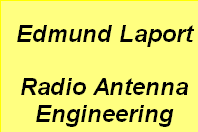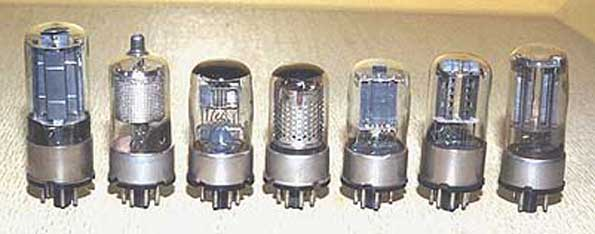


Antentop is FREE e-magazine devoted to Antennas and Amateur Radio an
Special page devoted to
Vacuum Tubes

Custom Search
|
ANTENTOP-
03- 2003, # 004
|
Vacuum Tubes
|
||
|
|
|||
|
6N7S (one triode), 6F6, 6J7 and 6K7
was used in the substitutes. The electric data (except heating voltage)
and the base were the same as in old valves. Such valves are very
rare now. |
Octal (8 pins) valves of the metallic
series. They have a directing spigot on the base. In the USSR their
production started in 1937. Valves with 6,3V indirect heating were
most widely used. Photo shows Soviet valves 6F6, 6A7, 6K3, 6G7,
6X6, 6L7. They were popular in the USSR till end 1950's.
|
||
|
1940's and a Soviet valve of the same period 6V6-GT - the ancestor of the well-known AF output tetrode 6P6S (in Russian). The "legendary" 6P3S valve had also undergone several modifications. Its history begins with the metallic 6L6 valve (Russian) of 1937 make. The first version of the home "in glass" 6L6 was no good because of overheating of the under-sized case. The valve 6P3 (Russian, made of glass, though not having the "S" at the end of the marking) produced in early 1950's did not show the required quality. Only in mid-1950's its construction was improved. That was the "classical" 6P3S already. It is produced even now with slight improvements and bears the marking of 6P3S-E and is a valve highly thought of among the audiophiles. The two-anode direct heating 5C3S kenotrone has also a long history. Among its predecessors there are both the old German valve of the "numeral" series RGN1064 and our VO-166. Similar valves existed in the European "A"-series (AZ1), and also in the US (5U4G, RCA80). |
Soviet octal valves in the bottles. 6,3 (12,6)V indirect heating. Enjoyed a wide spread in the
USSR somewhat later than metallic ones, often being their cheaper
equivalents. Among them we can point out a group of valves with
a high heating tension for series connection of the filaments in
transformerless shemes (see "Rekord-47"). Photo shows valves 6P3, 6N7S, 5C3S, 6P6S, 6F5M,
6F6S, 6E5, horizontally - 30C6S.
|
||
|
|
|
||
|
Home-produced
valves of higher durability with metallic rings over the bases:
|
|||
|
|
|
||
|
|
Page 96 |
||
 |
 |
 |
 |
Just for Fun:

Powered byIP2Location.com
Thanks for your time!
Last Updated:
February 29, 2020 23:12







